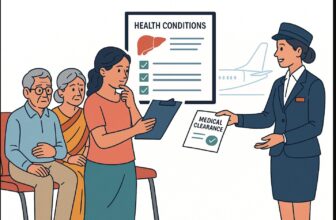In India, belly fat is a growing concern, especially with increasing urban lifestyles, desk jobs, and high-carb diets. Many people turn to walking and cycling as simple, cost-effective ways to stay fit and reduce belly fat. But which one works better?
Both cycling and walking are popular in India, whether it’s commuting to work, exercising in parks, or using gym cycles. But when it comes to burning belly fat, the effectiveness of each depends on factors like calorie burn, fat metabolism, muscle engagement, and intensity.
This list provides a detailed comparison of cycling and walking for belly fat loss, using data and real-world considerations specific to Indian lifestyles, road conditions, and fitness habits.
1. Calorie Burn: Cycling vs. Walking in Indian Conditions
1.1 Cycling – Higher Caloric Burn
- A 70 kg person burns approximately:
- 238 kcal in 30 minutes of moderate cycling (20-22 km/h).
- 298 kcal in 30 minutes of fast cycling (22-26 km/h).
- 372 kcal in 30 minutes of intense cycling (26+ km/h or uphill).
- Outdoor cycling on Indian roads may require more effort due to traffic, road conditions, and elevation changes, leading to higher calorie expenditure.
- Stationary cycling in gyms or using home exercise bikes provides a controlled environment for consistency.
1.2 Walking – Lower but Consistent Caloric Burn
- A 70 kg person burns approximately:
- 126 kcal in 30 minutes of normal walking (5 km/h).
- 149 kcal in 30 minutes of brisk walking (6 km/h).
- 186 kcal in 30 minutes of uphill walking (5% incline).
- Walking on uneven terrain, such as Indian parks, hilly areas, or streets, increases effort and calorie burn.
- Adding weight (backpacks or ankle weights) can enhance calorie expenditure.
Conclusion on Calorie Burn
Cycling burns nearly twice as many calories per minute compared to walking, making it a better choice for faster weight loss. However, walking longer durations can compensate for the lower calorie burn.
2. Belly Fat Reduction & Fat Metabolism
2.1 Cycling: High-Intensity Fat Loss
- Works larger muscle groups (legs, glutes, and core), increasing overall metabolism.
- High-intensity cycling (HIIT cycling) increases post-exercise oxygen consumption (EPOC), meaning you continue burning calories even after exercise.
- Studies show cycling reduces visceral fat (belly fat stored around organs) faster than moderate walking.
2.2 Walking: Fat Oxidation for Sustainable Loss
- Low-intensity walking relies more on fat oxidation, meaning the body uses stored fat for energy.
- Walking for 60+ minutes at a moderate pace improves belly fat metabolism.
- A study in India showed that daily brisk walking significantly reduces waist circumference over 12 weeks.
Conclusion on Fat Metabolism
Cycling is more effective for rapid belly fat loss due to its higher intensity and muscle engagement. However, walking is better for long-term fat burning, especially for beginners or those with joint issues.
3. Muscle Engagement & Body Toning
3.1 Cycling – Strengthens Lower Body Muscles
- Engages quadriceps, hamstrings, glutes, and calves.
- Builds leg strength, increases muscle mass, and improves metabolism.
- Better for leg toning and endurance building.
3.2 Walking – Tones Core and Lower Body
- Activates core muscles when maintaining posture.
- Brisk walking and incline walking engage glutes and hamstrings.
- Does not build muscle but helps in overall toning.
Conclusion on Muscle Engagement
Cycling helps build lower-body muscle, improving fat-burning capacity over time. Walking tones the body but does not significantly increase muscle mass.
4. Intensity & Fat Loss Efficiency
4.1 Cycling – More Intensity, Faster Results
- HIIT cycling (short bursts of high speed) increases belly fat loss by stimulating fat-burning hormones.
- Steady-state cycling (moderate pace for 45-60 minutes) also helps but works slower than HIIT.
- Requires more effort but burns more fat per minute.
4.2 Walking – Low Intensity, Long Duration Needed
- Requires at least 60 minutes per session to match the fat loss benefits of 30 minutes of cycling.
- Incline walking (hills or treadmill) increases intensity and fat burn.
- Best suited for people who prefer a lower-intensity workout.
5. Practicality in Indian Lifestyle
5.1 Cycling – Requires Equipment but Efficient
Pros:
- Burns more calories per minute.
- Low-impact, good for joint health.
- Can be done outdoors or indoors (gym cycling).
Cons:
- Requires a bicycle, helmet, and safe roads.
- Indian traffic and road conditions can be challenging.
5.2 Walking – Easiest and Most Accessible
Pros:
- Can be done anywhere, anytime (parks, streets, treadmill).
- Free, no equipment needed.
- Good for all fitness levels, including elderly and beginners.
Cons:
- Takes longer to burn calories compared to cycling.
- Limited intensity compared to cycling.
Verdict: Which is Better for Belly Fat Reduction in India?
| Factor | Cycling | Walking |
|---|---|---|
| Calories Burned | More per minute | Less per minute |
| Fat Metabolism | Boosts metabolism | Uses stored fat efficiently |
| Muscle Engagement | Builds leg muscles | Tones muscles but no muscle growth |
| Intensity & Fat Loss | Faster belly fat loss at higher intensity | Slower but sustainable |
| Practicality in India | Needs equipment & safe roads | Easiest & most accessible |
Best Approach for Maximum Belly Fat Reduction in India
- Cycle 3-4 times a week (moderate to high intensity, 30-45 min) for fast belly fat loss.
- Walk briskly 5-6 days a week (45-60 min) for sustained fat oxidation.
- Add incline walking or hills for extra fat burn.
- Maintain a calorie deficit with a balanced Indian diet (rich in protein, fiber, and healthy fats).
Summary: Cycling or Walking?
Both cycling and walking are effective for reducing belly fat, but the best choice depends on individual goals.
Cycling burns more calories per minute and engages more muscles, leading to faster fat loss. It is ideal for those looking for higher-intensity workouts. However, access to a bicycle, safe roads, or gym equipment may be a challenge in many Indian cities.
Walking is the easiest and most accessible option, requires no equipment, and can be done anywhere, including parks, roads, or even indoors. While it burns fewer calories per minute than cycling, longer walks at a brisk pace or walking uphill can be highly effective for fat loss over time.
Final Takeaway
- For faster belly fat loss – Cycling (especially high-intensity cycling or HIIT).
- For a sustainable, everyday routine – Walking (especially brisk or incline walking).
- For best results – A mix of both activities, along with a healthy Indian diet and strength training.
If you’re looking for long-term fat loss and fitness, choose the option that fits your lifestyle, consistency, and comfort in India’s urban or rural settings.





